Lavochkin La-5
The Lavochkin La-5 (Лавочкин Ла-5) was a Soviet fighter aircraft of World War II. It was a development and refinement of the LaGG-3, replacing the earlier model's inline engine with the much more powerful Shvetsov ASh-82 radial engine. During its time in service, it was one of the Soviet Air Force's most capable types of warplane, able to fight German designs on an equal footing.
| La-5 | |
|---|---|
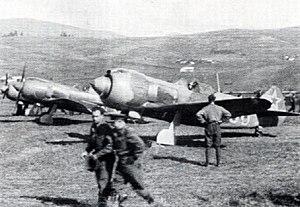 | |
| Role | Fighter aircraft |
| Manufacturer | Lavochkin |
| Designer | Semyon Lavochkin |
| First flight | March 1942 |
| Introduction | July 1942 |
| Primary user | Soviet Air Force |
| Number built | 9,920 |
| Variants | Lavochkin La-7 |
Development
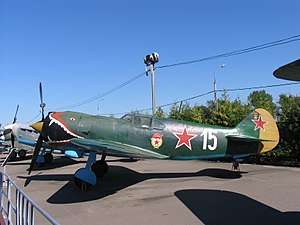
The La-5's heritage began even before the outbreak of war, with the LaGG-1, a promising yet under-powered aircraft. The LaGG-3 was a modification of that design that attempted to correct this by both lightening the airframe and fitting a more powerful engine. Nevertheless, this was not enough, and the lack of power remained a significant problem.
In early 1942 the LaGG-1 and -3's designer Vladimir Gorbunov attempted to correct this deficiency by experimentally fitting a LaGG-3 with the more powerful Shvetsov ASh-82 radial engine. Since the LaGG-3 was powered by an inline engine, they accomplished this by grafting on the nose section of a Sukhoi Su-2 (which used this engine). By now, the shortcomings of the LaGG-3 had caused Lavochkin to fall out of Joseph Stalin's favour, and factories previously assigned to LaGG-3 construction had been turned over to building the rival Yakovlev Yak-1 and Yak-7. The design work, which required that the LaGG-3 be adapted to its new engine and still maintain the aircraft's balance, was undertaken by Lavochkin in a small hut beside an airfield over the winter of 1941–1942, on a completely unofficial basis.
When the prototype took flight in March, the result was surprisingly pleasing – the fighter finally had a powerplant that allowed it to perform as well in the air as it had been supposed to on paper. After flying, the LaG-5 (the change in name reflecting that one of the original LaGG designers, Mikhail I. Gudkov, was no longer with the programme), Air Force test pilots declared it superior to the Yak-7, and intensive flight tests began in April.
By July, Stalin ordered maximum-rate production of the aircraft and the conversion of any incomplete LaGG-3 airframes to the new configuration, now simply known as the La-5 (despite Vladimir P. Gorbunov still being with the programme). The prototype was put in mass production almost immediately in factories located in Moscow and in the Yaroslav region. Design changes for main production La-5 models included slats to improve all-round performance. While still inferior to the best German fighters at higher altitudes, the La-5 proved to be every bit their match closer to the ground. With most of the air combat over the Eastern Front taking place at altitudes of under 5,000 m (16,404 ft), the La-5 was very much in its element.
Further refinement of the aircraft involved cutting down the rear fuselage to give the pilot better visibility, making this version the La-5F. Later, a fuel-injected engine, a different engine air intake and further lightening of the aircraft led to the designation La-5FN that would become the definitive version of the aircraft. A full circle turn took 18–19 seconds. Altogether, 9,920 La-5s of all variants were built, including a number of dedicated trainer versions, designated La-5UTI. Very late La-5FN production models had two 20mm Berezin B-20 cannon installed in the cowling in place of the heavier two 20mm ShVAK (both were capable of a salvo weight of 3.4 kg/s). Further improvements of the aircraft would lead to the Lavochkin La-7.
A number of La-5s continued in the service of Eastern Bloc nations after the end of the war, including Czechoslovakia.
Flying the La-5
In the summer of 1943, a brand-new La-5 made a forced landing on a German airfield, providing the Luftwaffe with an opportunity to test-fly the newest Soviet fighter. Test pilot Hans-Werner Lerche wrote a detailed report of his experience.[1] He particularly noted that the La-5FN excelled at altitudes below 3,000 m (9,843 ft) but suffered from short range and flight time of only 40 minutes at cruise engine power. All of the engine controls (throttle, mixture, propeller pitch, radiator and cowl flaps, and supercharger gearbox) had separate levers which forced the pilot to make constant adjustments during combat or risk suboptimal performance. For example, rapid acceleration required moving no less than six levers. In contrast, contemporary German aircraft with the BMW 801 used the Kommandogerät engine computer system that automatically controlled all of these settings from a single throttle lever. Due to airflow limitations, the engine boost system (Forsazh) could not be used above 2,000 m (6,562 ft). Stability in all axes was generally good. The authority of the ailerons was deemed exceptional but the rudder was insufficiently powerful at lower speeds. At speeds in excess of 600 km/h (370 mph), the forces on control surfaces became excessive. Horizontal turn time at 1,000 m (3,281 ft) and maximum engine power was 25 seconds.
The La-5 was found to have a top speed and acceleration at low altitude that were comparable to Luftwaffe fighters. The La-5FN possessed a slightly higher roll rate than the Bf-109. However, the Bf-109 was slightly faster and had the advantage of a higher rate of climb and better turn rate.[2] The La-5FN had a slightly better climb rate and smaller turn radius than the Fw 190A-8. However, the Fw 190A-8 was faster at all altitudes and had significantly better dive performance and a superior roll-rate. As a result, Lerche's recommendations for Fw 190 pilots were to attempt to draw the La-5FN to higher altitudes, to escape attacks in a dive followed by a high-speed shallow climb, and to avoid prolonged turning engagements. Utilizing MW 50 both German fighters had superior performance at all altitudes.
The La-5 had its defects. Perhaps the most serious was the thermal isolation of the engine, lack of ventilation in the cockpit, and a canopy that was impossible to open at speeds over 350 km/h. To make things worse, exhaust gas often entered the cockpit due to poor insulation of the engine compartment. Consequently, pilots ignored orders and frequently flew with their canopies open.[3]
In general, Soviet pilots appreciated the La-5 as an effective fighter. "That was an excellent fighter with two cannons and a powerful air-cooled engine", recalled pilot Viktor M. Sinaisky. "The first La-5s from the Tbilisi factory were slightly inferior, while the last ones from the Gorki plant, which came to us from Ivanovo, were perfect. At first we received regular La-5s, but then we got new ones containing the ASh-82FN engine with direct injection of fuel into the cylinders. It was perfected and had better maneuverability, acceleration, speed and climb rate compared to the early variants. Everyone was in love with the La-5. It was easy to maintain, too."[4] Nevertheless, La-5 losses were high, the highest of all fighters in service in USSR, excepting those of the Yak-1. In 1941–45, VVS KA lost 2,591 La-5s: 730 in 1942, 1,460 in 1943, 825 the following year, and 233 in 1945.[5]
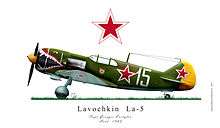 La-5
La-5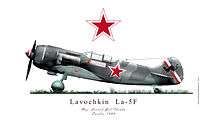 La-5F
La-5F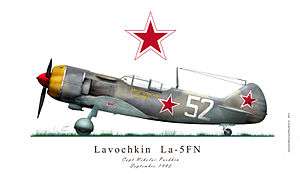 La-5FN
La-5FN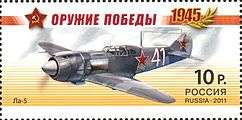 La-5 on Russian stamp
La-5 on Russian stamp
Operational history
The La-5F arrived at the frontline in February 1943. It was able to challenge the Messerchmitt Bf 109G-2 and the Focke-Wulf Fw 190A-4 on more or less equal terms, while at tree-top height it was even faster. One of the most successful La-5 units was 5 GIAP, that flew 3,802 combat sorties, claiming 128 enemy aircraft shot down while losing 52 Lavochkins.[6]
Survivors
The only known La-5 in existence is a wreck in storage at the Military Aviation Museum in Virginia, United States.[7]
Operators
- Czechoslovakian Air Force like S-95
- Czechoslovakian National Security Guard
- Mongolian People's Army Air Force
- Polish Air Force – One aircraft only.
- Soviet Air Force
Specifications (Lavochkin La-5FN)
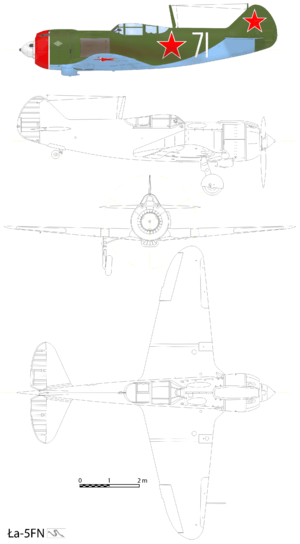
Data from Istoriia konstruktskii samoletov v SSSR, 1938–1950[8], Jane's Fighting Aircraft of World War II[9]
General characteristics
- Crew: 1
- Length: 8.67 m (28 ft 5 in)
- Wingspan: 9.8 m (32 ft 2 in)
- Height: 2.54 m (8 ft 4 in)
- Wing area: 17.5 m2 (188 sq ft)
- Airfoil: root: NACA 23016; tip: NACA 23010[10]
- Empty weight: 2,706 kg (5,966 lb)
- Gross weight: 3,168 kg (6,984 lb)
- Max takeoff weight: 3,402 kg (7,500 lb)
- Fuel capacity: 345 kg (761 lb) fuel + 50 kg (110 lb) oil
- Powerplant: 1 × Shvetsov M-82FN 14-cylinder air-cooled radial piston engine, 1,460 kW (1,960 hp)
- Propellers: 3-bladed constant-speed propeller
Performance
- Maximum speed: 648 km/h (403 mph, 350 kn) at 6,250 m (20,505 ft)
- 583 km/h (362 mph; 315 kn) at sea level
- Landing speed: 138 km/h (86 mph; 75 kn)
- Range: 765 km (475 mi, 413 nmi)
- Service ceiling: 11,000 m (36,000 ft)
- Rate of climb: 16.7 m/s (3,290 ft/min)
- Time to altitude: 5,000 m (16,404 ft) in 5 minutes 12 seconds
- Wing loading: 181 kg/m2 (37 lb/sq ft)
- Power/mass: 0.461 kW/kg (0.280 hp/lb)
- Max rate turn: 18.5 seconds
Armament
- Guns: 2 × 20 mm (0.787 in) ShVAK cannon with 200 rpg
- Bombs: 2 × bombs up to 100 kg (220 lb) each
See also
Related development
Aircraft of comparable role, configuration and era
Related lists
References
Notes
- Котлобовский, А. (Kotlobovskiy, A.) and В. Блащук, (V. Blaschuk) "Ла-5ФH с точки зрения люфтваффе (La-5FN from the viewpoint of Luftwaffe)." АэроХобби (AeroHobby), Issue 1, 1993.
- Luftwaffe Test Pilot by Hans Werner Lerche, Page 158
- Drabkin 2007, p. 148.
- Drabkin 2007, p. 73.
- Bergström 2008, p. 132.
- Bergstrom 2019, p. 195.
- "Lavochkin La-5 photos by Robert N. Abbott Jr". Retrieved 2004-02-27.
- Shavrov, V.B. (1994). Istoriia konstruktskii samoletov v SSSR, 1938–1950 : Table 18 (in Russian) (gg. (3 izd.) ed.). Moscow: Mashinostroenie. ISBN 978-5-217-00477-5.
- Bridgman 1946, p. 195.
- Lednicer, David. "The Incomplete Guide to Airfoil Usage". m-selig.ae.illinois.edu. Retrieved 16 April 2019.
Bibliography
- Abanshin, Michael E. and Nina Gut. Fighting Lavochkin, Eagles of the East No.1. Lynnwood, WA: Aviation International, 1993. ISBN unknown.
- Bergström, Christer. Bagration to Berlin – The final Air Battle in the East 1944–45. Hersham UK, Classic Publications, 2008. ISBN 978-1-903223-91-8.
- Bergström, Christer. Black Cross – Red Star, Air War over the Eastern Front. Volume 4. Stalingrad to Kuban. Vaktel Books, 2019. ISBN 978-91-88441-21-8
- Bergström, Christer. Kursk – The Air Battle: July 1943. London: Chevron/Ian Allan, 2007. ISBN 978-1-903223-88-8.
- Bridgman, Leonard (ed.). "The La-5". Jane's Fighting Aircraft of World War II. London: Studio, 1946. ISBN 1-85170-493-0.
- Drabkin, Artem. The Red Air Force at War: Barbarossa and the Retreat to Moscow – Recollections of Fighter Pilots on the Eastern Front. Barnsley, South Yorkshire, UK: Pen & Sword Military, 2007. ISBN 1-84415-563-3.
- Glancey, Jonathan. Spitfire: The Illustrated Biography. London: Atlantic books, 2006. ISBN 978-1-84354-528-6.
- Gordon, Yefim. Lavochkin's Piston-Engined Fighters (Red Star Volume 10). Earl Shilton, Leicester, UK: Midland Publishing Ltd., 2003. ISBN 1-85780-151-2.
- Gordon, Yefim and Dmitri Khazanov. Soviet Combat Aircraft of the Second World War, Volume One: Single-Engined Fighters. Earl Shilton, Leicester, UK: Midland Publishing Ltd., 1998. ISBN 1-85780-083-4.
- Green, William. Warplanes of the Second World War, Volume Three: Fighters. London: Macdonald & Co. (Publishers) Ltd., 1961 (seventh impression 1973). ISBN 0-356-01447-9.
- Green, William and Gordon Swanborough. WW2 Aircraft Fact Files: Soviet Air Force Fighters, Part 1. London: Macdonald and Jane's Publishers Ltd., 1977. ISBN 0-354-01026-3.
- Liss, Witold. The Lavochkin La 5 & 7 (Aircraft in Profile number 149). Leatherhead, Surrey, UK: Profile Publications Ltd., 1967.
- Stapfer, Hans-Heiri. La 5/7 Fighters in Action (Aircraft in Action Number 169). Carrollton, Texas: Squadron/Signal Publications, Inc., 1998. ISBN 0-89747-392-2.
- Stapfer, Hans-Heiri. LaGG Fighters in Action (Aircraft in Action Number 163). Carrollton, Texas: Squadron/Signal Publications, Inc., 1996. ISBN 0897473647
- Veštšík, Miloš and Jirí Vraný. Lavočkin La-5 (in Czech/English). Prague, Czech Republic: MBI Books, 2006. ISBN 80-86524-10-8.
External links
| Wikimedia Commons has media related to Lavochkin La-5. |